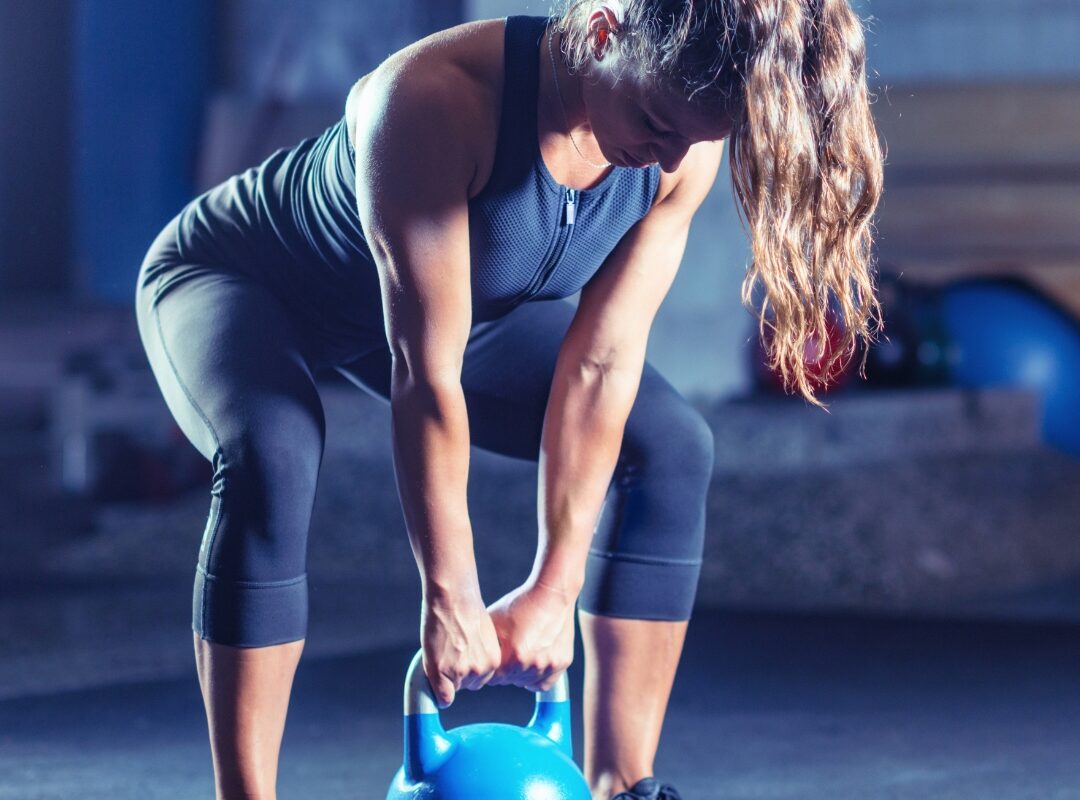

Muscle Cramps: Debunking Myths About How to Prevent Them
Dive into muscle cramp myths with Marily Oppezzo, explore the latest research stance, and find out what to do if cramps are crashing your workouts.
December 18, 2024

Marily Oppezzo, Ph.D., M.S., R.D.N.
Dr. Marily Oppezzo is a registered dietician, a learning and behavioral scientist, and an Instructor of Medicine with the Stanford Prevention Research Center. She is also a Clinician-Scientist Fellow with the Wu Tsai Human Performance Alliance at Stanford.

Ashton Eaton, OLY
Ashton Eaton is a decathlete and two-time Olympic champion who holds the world record in the indoor heptathlon event. Since retiring from the sport, he has become a mechanical engineer at Nike.
It’s the middle of a race and everything is going according to plan…. until it isn’t. Your calf tightens into a painful knot. You slow down, frustrated. Despite all your preparation, a muscle cramp stops you in your tracks. But why now? Could you have done something differently?
Ashton Eaton, a decathlete and two-time Olympic champion, knows this experience all too well. “I remember having muscle cramps since middle school,” said Eaton. “They would always happen in my legs, especially my calves and my hamstrings.”
Typically, Eaton’s cramps would occur post-activity, either during dinner or at night. But in the 2015 season, something changed. “I found myself cramping in practice, which is something that had never happened before,” said Eaton. “I actually had to stop my practices, which was not good.”

Canva Pro Images
Known in the scientific literature as “exercise-associated muscle cramps (EAMC),” this condition is a common nemesis for athletes. It occurs when a skeletal muscle seizes in an involuntary, painful contraction during or after exercise in a healthy individual with no underlying medical reasons.
As Eaton got older and sport became his profession, muscle cramps became a bigger concern. “The decathlon at the Olympic Games is a two day event, and a lot of fatigue accumulates throughout the body,” said Eaton. “The last event is basically a mile, and I always held back in that event. I didn’t push myself from the start because I was concerned that halfway through I might get a muscle cramp and not be able to finish.”
Eaton sought expert advice and found ways to manage his muscle cramps. So, what can you do to reduce your chances of cramping up?
Myth: Eating a Banana Helps Prevent Muscle Cramps
One popular myth is that eating potassium-rich bananas before a race can help prevent muscle cramps. Unfortunately, this notion is… a bit bananas. There is no evidence that eating potassium-rich foods before a race can prevent muscle cramps, especially if your baseline levels are already within normal range.1,2
“Bananas are great for many nutritional reasons, but they will not help you to avoid cramping,” said Dr. Marily Oppezzo. Curious why? Read the electrolyte section below.

Training Tip
Eating potassium-rich foods like bananas immediately before a race is unlikely to prevent muscle cramps. While you may find articles from reputable sources relating the two, these pieces are typically discussing medical conditions, where cramps occur outside of exercise.

Canva Pro Images
Do Electrolytes or Temperature Influence Muscle Cramps?
When it comes to warding off those painful calf cramps mid-race, there is no consensus. Even though electrolytes – minerals like potassium, calcium, and magnesium, as well as salt – have traditionally been thought to be related to EAMCs, there is no hard-and-fast rule. Studies have shown that athletes with cramps have similar electrolyte concentrations in their blood as those who don’t experience cramps during competitions.1,3

What is the extent of research on electrolytes and cramps?
The two reviews looking at how electrolytes affect muscle cramps highlight a limited range of research, with only six unique studies mentioned. This small pool of research makes it hard to draw broad conclusions about the relationship between electrolytes and muscle cramps, as it may not fully capture the variety of conditions, populations, and potential variables involved.
Another consideration is that low electrolyte levels are a systemic issue and unlikely the sole cause of muscle cramps in a specific region, such as the calf. That’s not to say they don’t play a role, but it’s unlikely the only cause of muscle cramps for most individuals. Instead, muscle cramps could be the result of a confluence of intrinsic factors (e.g., lack of conditioning, fatigue) and extrinsic factors (e.g., temperature), which likely differ from person to person.1,4
And while the Internet abounds with information about “heat cramps,” EAMCs can also occur in cold weather. A study from 1986 found that 18% of runners experienced cramps while participating in a marathon in cold weather, where temperatures ranged from 10-12 °C.5

Training Tip
Muscle cramps may be the result of a confluence of several factors, which likely differ from person to person.
What About Fatigue?
Recent research points to “fatigue-induced alterations in nervous system excitability” as a possible risk factor. In simpler terms, pushing your body beyond its usual limits.1 One study found that cramping during an ultra-marathon was linked to a faster running pace early on in the race, though it didn’t affect final race times.6 The 1986 marathon study included 82 runners and noted that cramps only occurred in the second half of the race.5 There isn’t much more evidence from actual races and training sessions to draw definitive conclusions about fatigue’s role right now.

Canva Pro Images
What Role Does Hydration Play?
As for hydration? The evidence is mixed. Some studies suggest hydration status showed little-to-no impact on the occurrence of muscle cramps, while others suggest it may have an influence. One study investigated how dehydration affects muscle cramps in individuals prone to EAMCs by reducing body water through sweating in a sauna. When body water decreased by 1%, 2%, and 3% of body mass, 3 out of 9 men experienced cramps in the 2% condition, and 6 in the 3% condition. The results of this very small study suggest that fluid loss from the body might increase the likelihood of muscle cramps.7
Yet, another study of 88 marathon runners observed no significant differences in hydration levels, based on urine measurements, between crampers and non-crampers.8 Again, it’s proposed that different situations may involve different mechanisms, with no single cause universally applicable.1,4
"Pounding water" can have dangerous consequences
Drinking large amounts of water quickly, also known as “pounding water,” can have dangerous consequences. It can lead to hyponatremia, which occurs when too much water dilutes the sodium levels in the blood. When sodium levels drop too low, water can enter the cells, causing them to swell, potentially leading to headaches, seizures, and other symptoms. Consuming large amounts of water is also a risk factor for muscle cramps.4 Sipping is better for hydration.
So, What Can You Do?
One of the risk factors for muscle cramps is a history of muscle cramps. Although this may not be reassuring, the best way to manage muscle cramps, given our current understanding, is through a personalized approach.1
“The best way to address muscle cramps is doing me-search,” said Dr. Oppezzo. “Maintaining a cramping diary can be helpful. If you have had a cramp in that area before, you’re more likely to get one in that area again. Documenting the circumstances – like location, activity, what you ingested – may help provide insights.”
When keeping a cramp diary, consider asking yourself the following questions:1

Made in Canva Pro
If muscle cramps do occur, gentle static stretching has been recommended to alleviate them.1,9

Training Tip
Keep a personalized muscle cramp diary to see if there is a pattern in what factors could be contributing to your muscle cramps.
Personalized Solution: How Ashton Eaton Managed His Muscle Cramps
Eaton spoke with an expert, who recommended he take a sweat sodium test to measure how much salt he was losing through sweat.
“I had one of the highest sodium losses you could have,” said Eaton. “At the same time, we were being more strict with our diet and eating lots of vegetables, so the idea was that I might not be getting enough sodium. Since adding more sodium into my diet, I haven’t cramped.”
Although not everyone may pinpoint a single cause like Eaton, they can take a personalized approach and experiment with what works best for their own cramp prevention.

Why don’t we have clear-cut answers for what causes muscle cramps?
It’s challenging to recreate real-world scenarios where muscle cramps occur. Researchers can cause muscle cramps via electrical stimulation, but these differ from sporting scenarios where fatigue or environmental factors may be at play.
Real-world research that is conducted on muscle cramps tends to make measurements after the cramps have occurred, for example, at the end of a race. So measurements don’t necessarily reflect what was happening when the cramp occurred. These are just two of the limitations that have hindered a better understanding of EAMCs.

Flash Q&A with Marily Oppezzo
What do you enjoy doing to stay active?
I love weight training, yoga, and pickleball.
What is your favorite go-to snack during activities?
I don’t typically snack during weight training. However, I eat a lot of nuts and popcorn. I also make overnight oats with kefir, oats, frozen blueberries, and whatever else I feel like. I grow a garden of fresh fruits and vegetables that feeds a bunch of squirrels – and I sometimes get strawberries from them.

Flash Q&A with Ashton Eaton
What do you enjoy doing to stay active?
I go to the gym and run. Even though I don’t trail run often, it’s one of my favorite activities to do. When we lived in San Francisco, I loved to run the Muir Beach Trail across the Golden Gate Bridge. You’re running along the Pacific Ocean on these beautiful hills near the cliff’s edge with views of the ocean. It’s fantastic.
What is your favorite go-to snack during activities?
I’m more utilitarian, so a sports bar or trail mix will suffice for me.
Get Deeply Researched Insights on Human Performance
Join our mailing list to get actionable performance tips and nuanced explanations of the science.
Citations
- Miller, K.C., McDermott, B.P., Yeargin S., et al. (2022). An evidence-based review of the pathophysiology, treatment, and prevention of Exercise-Associated muscle cramps. Journal of Athletic Training. 57(1), 5-15. https://doi.org/10.4085/1062-6050-0696.20
- Murray D., Miller K., Edwards J. (2016). Does a reduction in serum sodium concentration or serum potassium concentration increase the prevalence of exercise-associated muscle cramps? Journal of Sport Rehabilitation. 25:301-304. https://doi.org/10.1123/jsr.2014-0293
- Giuriato G., Pedrinolla A., Schena F., et al. (2018). Muscle cramps: A comparison of the two-leading hypothesis. Journal of Electromyography and Kinesiology. 41:89-95. https://doi.org/10.1016/j.jelekin.2018.05.006
- Maughan R.J., Shirreffs S.M. (2019). Muscle cramping during exercise: causes, solutions, and questions remaining. Sports Medicine. 49:115-124. https://doi.org/10.1007/s40279-019-01162-1
- Maughan, R. J. (1986). Exercise‐induced muscle cramp: A prospective biochemical study in marathon runners. Journal of Sports Sciences. 4(1), 31–34. https://doi.org/10.1080/02640418608732095
- Schwellnus M.P., Allie S., Derman W., et al. (2011) Increased running speed and pre-race muscle damage as risk factors for exercise-associated muscle cramps in a 56 km ultra-marathon: a prospective cohort study. British Journal of Sports Medicine. 45: 1132-1136. https://doi.org/10.1136/bjsm.2010.082677
- Ohno M., Lavender A.P., Sawai A. (2018). Heat-induced body fluid loss causes muscle cramp during maximal voluntary contraction for the knee flexors. International Journal of Sport and Health Science. 1:191–9. https://doi.org/10.5432/ijshs.201729
- Martínez-Navarro I., Montoya-Vieco A., Collado E., et al. (2022) Muscle cramping in the marathon: dehydration and electrolyte depletion vs. muscle damage. Journal of Strength and Conditioning Research. 36(6):1629-1635. https://doi.org/10.1519/JSC.0000000000003713
- Miller T., Layzer R. (2005). Muscle cramps. Muscle and Nerve. 32(4): 431-442. https://doi.org/10.1002/mus.20341
Playbook Terms of Use & Copyright
©2023-2024



